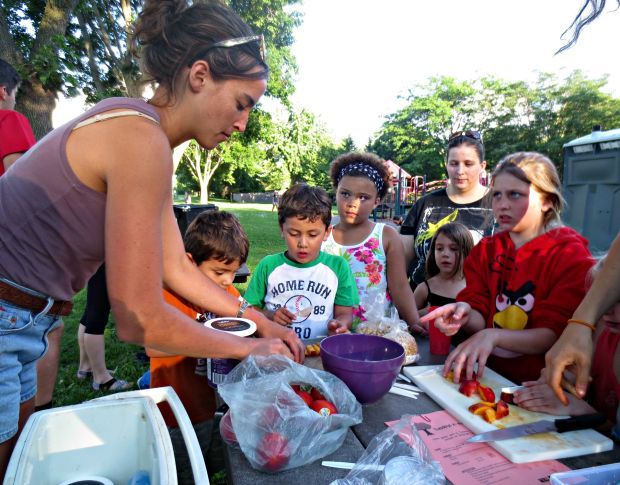
Share On Social!
College friends Tori Ostenso and Emily Pence met through volunteer opportunities while in school.
They soon learned there was plenty of fresh produce in their neighborhoods, but immigrant families lacked access to these healthy options in Rice County, Minn. (8% Latino population).
The two students wanted to help.
They eventually started a mobile market and eventually began a weekly program to help Latino and other families have greater access to an affordable bag full of fresh local organic vegetables.
Abundant Fresh Produce, But Inequitable Access
Victoria (Tori) Ostenso became keenly aware of the bounty of healthy fresh produce grown in Northfield, Minn (8.4% Latino) while working at Carleton College’s two-acre organic vegetable farm in summer 2012 after her freshman year at the school.
Ostenso and her friend, Emily Pence, had even started a “gleaning” program at the school—where leftover produce from harvests is collected and given to the local food pantry. They also helped start a college cooking club, called “Firebellies,” which later expanded to a youth club, to teach how to cook using fresh produce.
But Ostenso also became aware that “not everyone was accessing this bounty” at farmer’s markets and food co-ops.
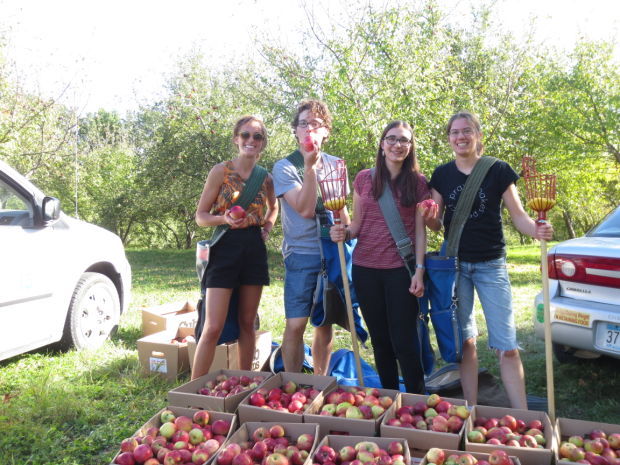
“You grow your food and you want it to be for everyone, not too expensive for certain groups of people, and that was really frustrating to me,” she said.
Later in 2012, Ostenso started volunteering with underprivileged Latina women in her community through Pura Vida, a wellness program that provides participants with free weekly bilingual fitness and nutrition classes.
There, Ostenso connected with Leah Eby, the coordinator of Growing Up Healthy (GUH), a program that works with partner organizations and immigrant and refugee families to cultivate leadership, foster social connectedness, and advocate for change within neighborhoods and systems.
During this time, Pence volunteered through Carleton’s Center for Community and Civic Engagement at elementary and middle schools , where she realized many students were not getting equal access to fresh, organic produce.
The residents in those schools and communities had cultural differences and language barriers that sometimes kept them from feeling comfortable in the local farmer’s markets, Pence said.
According to a County Profile for Minnesota’s Southeast Region, which includes Rice County, the rate of the Hispanic/Latino populations in the area increased at a rate of 74.5% between 2000 and 2010, and Spanish is the second most commonly spoken language in the area at 12.1%.
Ostenso, hoping to help offset school expenses and get future funding to support her own community-based program, learned about and applied to the Phillips Scholarships Program, a scholarship helps support potential leaders, that excel in their grades and hope to dedicate a portion of their lives to community service.
Ostenso hoped the funding would help feed her passion for helping the communities she was already volunteering with, but in a way that would bring in both her skills as a farmer and a cooking class instructor.
Could a Garden Work?
In 2013, Ostenso received the Phillips scholarship, pushing her to start thinking about how she could build community support around healthy food access for all.
“That’s when I got to thinking, what sort of community-based program could I do, to really help this community and work with my interests,” Ostenso said.
In January of 2014, after brainstorming project ideas, Ostenso reached out to Eby.
They discussed the five communities GUH works with, and Eby explained to Ostenso that many of the communities have little gardens in their homes or neighborhoods, but they unfortunately, have not connected to the local food system because of transportation, cost, and/or language barriers.
Ostenso started emailing different groups and organizations, including local farmers, to see of they would be interested in meeting up with her to develop project ideas she had in mind.
Ostenso initially thought a community garden program would be the best solution.
Her original idea would be to develop community gardens that sell homemade produce and salsas and serve as a teaching site for entrepreneurial skills to local Latinas, helping to bring the community into the local food system.
But after a few conversations with several groups, Ostenso said community gardens weren’t the best idea.
“I was discouraged from that idea because of previous community garden attempts, where families just didn’t have the time to work out in the farms,” Ostenso said. “It definitely changed a lot from the first thing I proposed.”
A Mobile Produce Market
After moving on from the idea of doing community gardens, Ostenso, Eby, and other interested groups began to discuss how they might increase food access by expanding GUH’s weekly community get-togethers, called “Nights in the Parks,” which already offered community members the opportunity to come together, participate in activities for kids and adults, and access information about local resources.
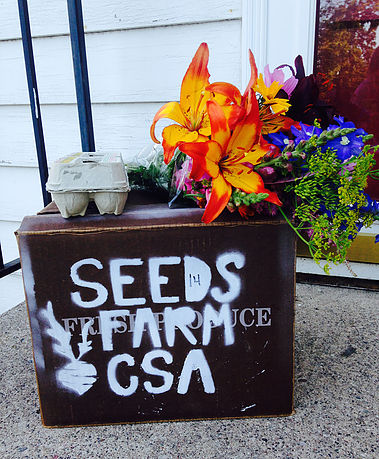
Ostenso had an idea: A mobile produce market might be a good addition to the weekly event.
The project, which they would eventually call Farmer to Family (FTF), would help low-income families in Northfield and Faribault combat the common barriers of transportation and cost to access healthy foods through a neighborhood mobile market at “Nights in the Park” events.
To explore how to make FTF work, Ostenso and Eby reached out to Becca Carlson, a local organic farmer and owner of SEEDS, who decided to help them buy 10 community shared agriculture (CSA) shares—a cardboard box full of pounds of varieties of fresh produce—at a lower-than-average cost from her farm.
The CSA shares would then be re-distributed amongst the 5 GUH communities that took part in “Nights in the Park” at an affordable price, along with cooking demonstrations that helped families see how to use the fresh produce in a healthy way.
The driving idea behind FTF was to bring local food that’s grown on the many farms in the area of Southeastern Minnesota, to neighborhoods that their organization works with, which traditionally have been geographically and socially isolated from the greater communities, Eby said.
Ostenso also reached out to her friend, Pence, to see if she could help run FTF.
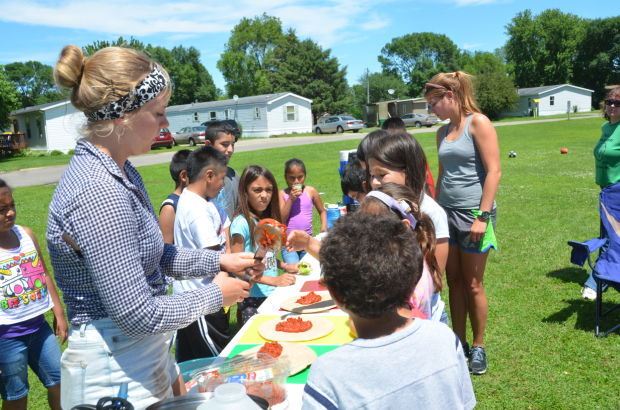
Both were focusing on food access and equity in their studies, and Pence jumped on the opportunity.
Eby also reached out to the local co-op, Just Food, where she knew she could get donations for the cooking demos from Stephanie Aman, the group’s marketing and member outreach coordinator in Northfield.
“[The Co-Op] were really enthusiastic and on board right away,” Eby said.
While at a GUH advisory board meeting, Eby found out about the local Neighborhood Health Connection Grant, which would help support their efforts to build community around healthy eating and help fund the program for the first year.
They applied for a local grant and continued to stay connected to future grant opportunities, as Eby met with the GUH advisory board on a bi-monthly basis.
Pence and Ostenso also wanted the program to last, so they decided to write a detailed manual to help run the program in the future, where GUH could hire or coordinate volunteers.
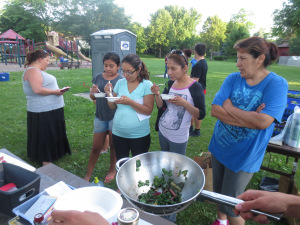
FTF would be run by the GUH coordinator and two individuals (i.e., student volunteers) with support from SEEDs Farm, the Carleton College Center for Community and Civic Engagement, the Phillips Scholarship, Healthy Rice County, the Allina Health Grant, and the Just Food Co-op.
“If we housed it in an organization, we could have a consistent person that was familiar with it besides two rotating students every year,” Pence said.
On a “Night in the Park” in June 2014, GUH, Ostenso, Pence, and Eby officially started the mobile market at Dresden Hill Park, and offered their first cooking demo, featuring cilantro lime vinaigrette for a summertime salad.
“We essentially just started selling fresh produce out of the back of my truck. We didn’t expect to sell many of the vegetables that night but kind just let them know were going to be here all summer,” said Ostenso. “It worked out pretty well.”
Continuing to Help
FTF has continued to help families across GUH’s five communities to access fresh and local vegetables on a consistent basis during summer “Nights in the Park,” along with occasional cooking demonstrations.
The program works within five underserved neighborhoods letting families fill up on local vegetables from the CSA shares at only $5 per full brown bag, introducing new foods in a fun, affordable way.
Eby and Ostenso got people to try and learn how to use new and unfamiliar fresh produce like kohlrabi, explaining that putting Tajin and lime was a big hit as it was a cultural treat that mimicked the popular jicama summer treat.
“That was cool too see, the parents try new things and then the kids also try new things, making green smoothies, eating the kohlrabi and just becoming more familiar with vegetables in general,” Eby said.
They also eventually ended up also presenting food demonstrations along with The Summer Food Service Program (SFSP), a program to give children free nutritious meals over the summer.
Ostenso also explained to the Phillips Scholars Program that the cooking demonstrations were very experimental, where kids and adults were trying new vegetables grown very near to their neighborhoods.
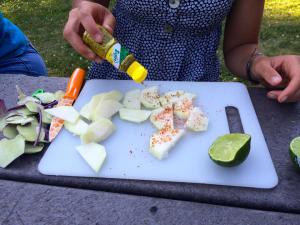
“The kids always wanted to make ice cream or pizza, but we challenged them to eat fruits and vegetables,” she said. “It was great to see the kids start making more nutritional choices.”
Getting Results
In the first year Ostenso estimated that they reached over 50 families with their FTF summer night market.
“I think the cooking demos were really good, if it’s an unfamiliar thing I think showing someone how to prepare, in a healthy, easy, fairly inexpensive way, was a really key part of the program,” said Pence.
Eby agreed.
“As far as health goes, I think it’s been really interesting to see how some of the people react to and then try to incorporate some of the food that’s grown here into their own weekly meal planning,” she said.
Eby continued the program into the second year in 2015 with the help of a Statewide Health Improvement Program (SHIP) grant through the Minnesota Department of Health.
Now into the program’s third summer in 2016, they hope to partner with Pura Vida’s weekly wellness program that implements exercise and nutrition along with healthy cooking classes.
Their other partnerships continue to blossom.
The Just Food Co-Op supports FTF with the “round-up” program, where every time someone shops they can round up their total dollar amount and the extra change provided by the shopper can go to help support FTF.
“[The Co-Op] have been really wonderful at trying to branch out from their business and do more community engagement and community support work, so they have supported us every year, with the round-up,” Eby said.
The SEEDS organic farm hopes to continue to support the CSA shares through CSA membership donations, offering each person the chance to buy a CSA share for FTF.
“The person that runs the farm has been very generous and trying to think about how they as a farm can continue to provide CSA shares even if were not able to fully cover their cost of purchasing [the shares],” Eby said.
Eby hopes to continue to develop the program and bring about stronger relationships between the neighborhoods and the farms, planning maybe someday in the future to bring families to the farm with field trips or bring farmers to group picnics.
“It has really been an exciting program that the neighborhoods have been involved in from the very beginning and have been excited about,” said Eby. “The program has changed because of their feedback and their engagement, which is really exciting.”
Explore More:
Healthy FoodBy The Numbers
1
Supermarket
for every Latino neighborhood, compared to 3 for every non-Latino neighborhood
This success story was produced by Salud America! with support from the Robert Wood Johnson Foundation.
The stories are intended for educational and informative purposes. References to specific policymakers, individuals, schools, policies, or companies have been included solely to advance these purposes and do not constitute an endorsement, sponsorship, or recommendation. Stories are based on and told by real community members and are the opinions and views of the individuals whose stories are told. Organization and activities described were not supported by Salud America! or the Robert Wood Johnson Foundation and do not necessarily represent the views of Salud America! or the Robert Wood Johnson Foundation.



